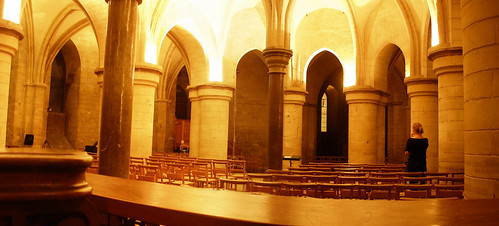Buildings That Protest
In Alain de Botton's The Architecture of Happiness, there is a passage where he considers the apparent failure of architecture as a device for making us better people.
 photo credit: Mr.Tea
photo credit: Mr.Tea
Not only do beautiful houses falter as guarantors of happiness, they can also be accused of failing to improve the characters of those who live in them.
...
Medieval devotional paintings may try to remind us of sadness and sin, they may seek to train us away from arrogance and worldly pursuits and render us properly humble before the mysteries and hardships of life, but they will hang in a living room without active protest while butlers circulate the fingerfood and butchers plot their next move.
Alain de Botton - The Significance of Architecture (from The Architecture of Happiness)If buildings haven't been able to protest in the past, it's because we haven't built them for it. They didn't have the eyes and ears to notice, nor the power to do something about it. That's beginning to change.Witness the new power-use visualization devices, perfect accessories to your environmental devotional, and a means to give mute buildings a voice and opinion about your ecological footprint. This is going mainstream. There is stimulus money. Google is getting involved. Machines to raise your consciousness, machines to make you feel shame.The Internet of Things expands. More devices are equipped with sensors and they can talk to each other about you. They notice that you spend too much time in front of the television. They wonder why you haven't been on the exercise bike in days. They gauge the volume of your voice, the pheromones in the air, the sharpness of your movements, and know that you've been fighting a lot.What to do with all of this information? Upload it to Daytum. Analyze it in iGoogle. Tweet about it.
Scenarios
A businessman programs in his New Years resolution. As he falls short of his best intentions, the house begins diverting power from the television, cutting it off completely for days at a time. Only miles on the exercise bike will restore the flow of entertainment.
A study links the colouring and lighting of rooms to the moods of the people therein. The methodology is weak and the conclusions disputed. It's enough to sell books and spike sales in colour-shift walls. Thousands of complex algorithms are marketed, promising to cross reference sensor data with the latest pseudo-science. Fire-engine red for energy, passion, and late night deadlines. Sea blue to calm arguments and children. Alternating goldenrod and pearl for concentration and intelligence. A software patched is released in order to address reported strobing events which could occur under certain conditions "in a small number of cases".
After the death of a child on a stretcher in a hallway, a special committee is convened. Battles erupt about patient confidentiality and data security. The Opposition makes headway in the poles by demanding the release of full waiting-room positional data. All new hospitals will have timers projected on to the walls above waiting visitors, counting up.
A small religious community commissions a planned community of morality houses. They are secretive and little is known about their practices. When reports do emerge, there are sensational headlines for weeks.
After the fourth shooting - the result of a toxic mix of firearms, frayed nerves, smart homes, and late night electronic intrusions - the Attorney General announces a crackdown on haunters, while urging new standards of encryption and security. "No one should be afraid in their own home."
The appeals process in the first gunman's case drags on.